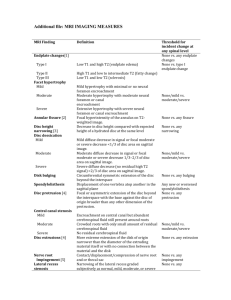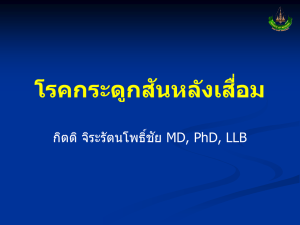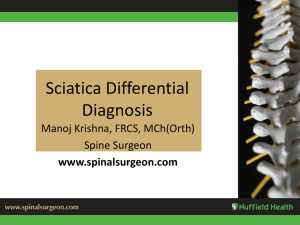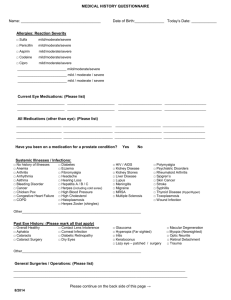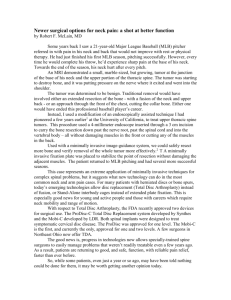appendix: mri imaging measures
advertisement
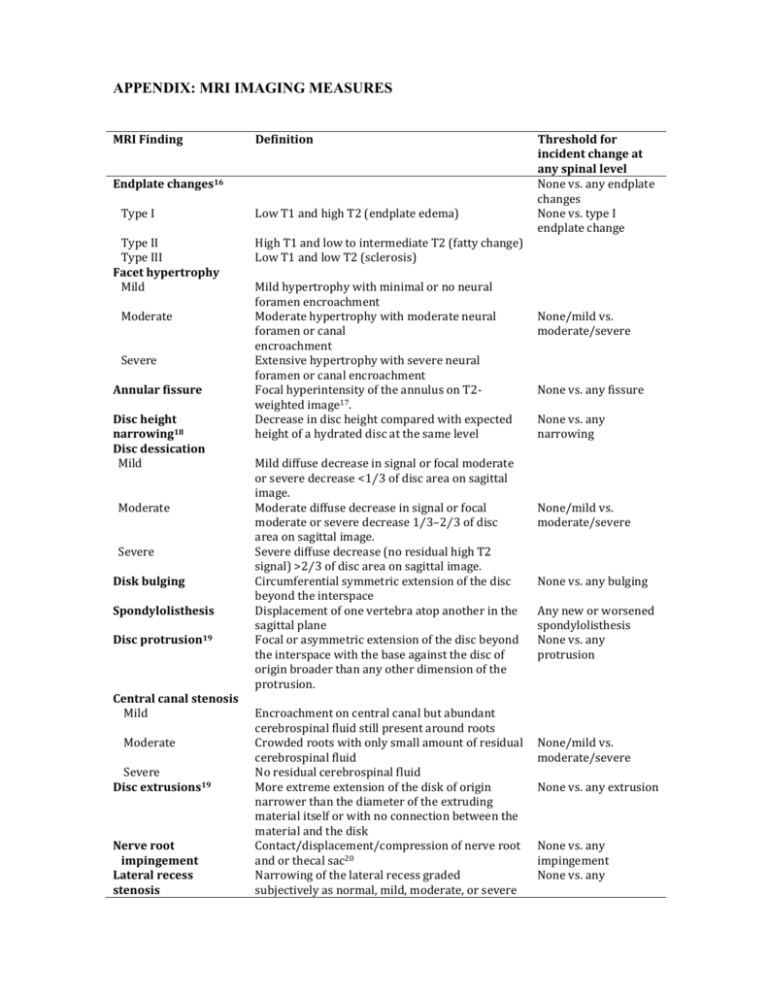
APPENDIX: MRI IMAGING MEASURES MRI Finding Definition Endplate changes16 Type I Type II Type III Facet hypertrophy Mild Moderate Severe Annular fissure Disc height narrowing18 Disc dessication Mild Moderate Severe Disk bulging Spondylolisthesis Disc protrusion19 Central canal stenosis Mild Moderate Severe Disc extrusions19 Nerve root impingement Lateral recess stenosis Low T1 and high T2 (endplate edema) Threshold for incident change at any spinal level None vs. any endplate changes None vs. type I endplate change High T1 and low to intermediate T2 (fatty change) Low T1 and low T2 (sclerosis) Mild hypertrophy with minimal or no neural foramen encroachment Moderate hypertrophy with moderate neural foramen or canal encroachment Extensive hypertrophy with severe neural foramen or canal encroachment Focal hyperintensity of the annulus on T2weighted image17. Decrease in disc height compared with expected height of a hydrated disc at the same level Mild diffuse decrease in signal or focal moderate or severe decrease <1⁄3 of disc area on sagittal image. Moderate diffuse decrease in signal or focal moderate or severe decrease 1⁄3–2⁄3 of disc area on sagittal image. Severe diffuse decrease (no residual high T2 signal) >2⁄3 of disc area on sagittal image. Circumferential symmetric extension of the disc beyond the interspace Displacement of one vertebra atop another in the sagittal plane Focal or asymmetric extension of the disc beyond the interspace with the base against the disc of origin broader than any other dimension of the protrusion. Encroachment on central canal but abundant cerebrospinal fluid still present around roots Crowded roots with only small amount of residual cerebrospinal fluid No residual cerebrospinal fluid More extreme extension of the disk of origin narrower than the diameter of the extruding material itself or with no connection between the material and the disk Contact/displacement/compression of nerve root and or thecal sac20 Narrowing of the lateral recess graded subjectively as normal, mild, moderate, or severe None/mild vs. moderate/severe None vs. any fissure None vs. any narrowing None/mild vs. moderate/severe None vs. any bulging Any new or worsened spondylolisthesis None vs. any protrusion None/mild vs. moderate/severe None vs. any extrusion None vs. any impingement None vs. any 1. Jarvik JG, Hollingworth W, Heagerty PJ, Haynor DR, Boyko EJ, Deyo RA. Three-year incidence of low back pain in an initially asymptomatic cohort: clinical and imaging risk factors. Spine (Phila Pa 1976) 2005;30:1541-8; discussion 9. 2. Jarvik JJ, Hollingworth W, Heagerty P, Haynor DR, Deyo RA. The Longitudinal Assessment of Imaging and Disability of the Back (LAIDBack) Study: baseline data. Spine (Phila Pa 1976) 2001;26:1158-66. 3. Patrick DL, Deyo RA, Atlas SJ, Singer DE, Chapin A, Keller RB. Assessing health-related quality of life in patients with sciatica. Spine (Phila Pa 1976) 1995;20:1899-908; discussion 909. 4. Suri P, Saunders KW, Von Korff M. Prevalence and characteristics of flare-ups of chronic nonspecific back pain in primary care: a telephone survey. Clin J Pain 2012;28:573-80. 5. Von Korff M. Studying the natural history of back pain. Spine (Phila Pa 1976) 1994;19:2041S-6S. 6. da Costa CML, Maher CG, Hancock MJ, McAuley JH, Herbert RD, Costa LO. The prognosis of acute and persistent low-back pain: a meta-analysis. Cmaj 2012;184:E613-24. 7. Katz JN. Lumbar disc disorders and low-back pain: socioeconomic factors and consequences. J Bone Joint Surg Am 2006;88 Suppl 2:21-4. 8. Chou D, Samartzis D, Bellabarba C, et al. Degenerative magnetic resonance imaging changes in patients with chronic low back pain: a systematic review. Spine (Phila Pa 1976) 2011;36:S43-53. 9. Hancock M, Maher C, Macaskill P, Latimer J, Kos W, Pik J. MRI findings are more common in selected patients with acute low back pain than controls? Eur Spine J 2012;21:240-6. 10. Jensen TS, Karppinen J, Sorensen JS, Niinimaki J, Leboeuf-Yde C. Vertebral endplate signal changes (Modic change): a systematic literature review of prevalence and association with non-specific low back pain. Eur Spine J 2008;17:1407-22. 11. Suri P, Hunter DJ, Rainville J, Kalichman L, Katz JN. Presence and Extent of Severe Facet Joint Osteoarthritis are Associated with Back Pain In Older Adults. Osteoarthritis Cartilage In press. 12. Katz JN, Chang LC, Sangha O, Fossel AH, Bates DW. Can comorbidity be measured by questionnaire rather than medical record review? Med Care 1996;34:73-84. 13. Bair MJ, Robinson RL, Katon W, Kroenke K. Depression and pain comorbidity: a literature review. Archives of internal medicine 2003;163:2433-45. 14. Fitzmaurice GM, Laird NM, Zahner GE, Daskalakis C. Bivariate logistic regression analysis of childhood psychopathology ratings using multiple informants. Am J Epidemiol 1995;142:1194-203. 15. Kessler RC, Sonnega A, Bromet E, Hughes M, Nelson CB. Posttraumatic stress disorder in the National Comorbidity Survey. Archives of general psychiatry 1995;52:1048-60. 16. Modic MT, Masaryk TJ, Ross JS, Carter JR. Imaging of degenerative disk disease. Radiology 1988;168:177-86. 17. Aprill C, Bogduk N. High-intensity zone: a diagnostic sign of painful lumbar disc on magnetic resonance imaging. Br J Radiol 1992;65:361-9. 18. Dabbs VM, Dabbs LG. Correlation between disc height narrowing and low-back pain. Spine (Phila Pa 1976) 1990;15:1366-9. 19. Jensen MC, Brant-Zawadzki MN, Obuchowski N, Modic MT, Malkasian D, Ross JS. Magnetic resonance imaging of the lumbar spine in people without back pain. N Engl J Med 1994;331:69-73. 20. Weishaupt D, Zanetti M, Hodler J, Boos N. MR imaging of the lumbar spine: prevalence of intervertebral disk extrusion and sequestration, nerve root compression, end plate abnormalities, and osteoarthritis of the facet joints in asymptomatic volunteers. Radiology 1998;209:661-6.
